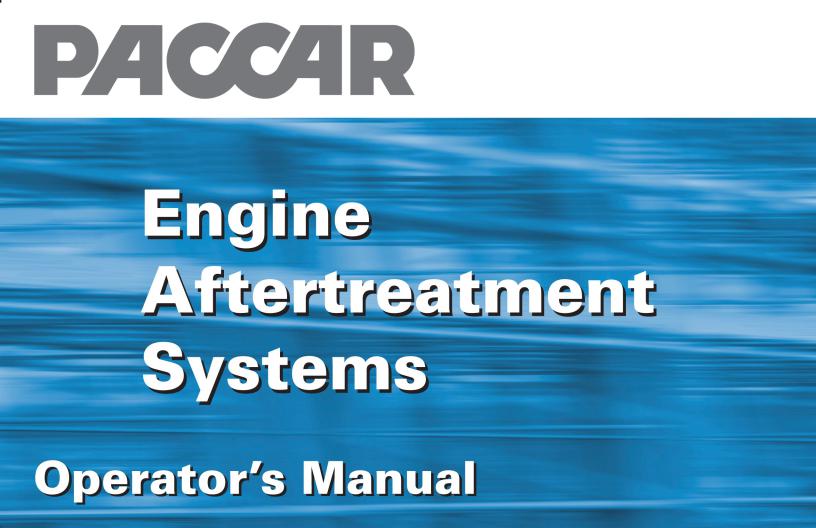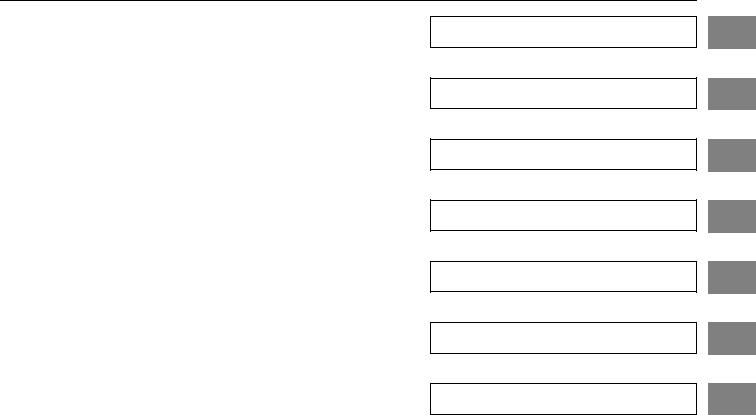PACCAR Engine Aftertreatment Systems Operator's Manual


Contents
Safety
Emergency
Controls
Driving
Maintenance
Information
1
2
3
4
5
6
Index 7

Contents
©2011 Paccar Inc - All Rights Reserved
This manual illustrates and describes the operation of features or equipment which may be either standard or optional on this vehicle. This manual may also include a description of features and equipment which are no longer available or were not ordered on this vehicle. Please disregard any illustrations or descriptions relating to features or equipment which are not on this vehicle.
PACCAR reserves the right to discontinue, change specifications, or change the design of its vehicles at any time without notice and without incurring any obligation.
The information contained in this manual is proprietary to PACCAR. Reproduction, in whole or in part, by any means is strictly prohibited without prior written authorization from PACCAR Inc.

SAFETY
Safety |
1 |
|
|
About This Manual . . . . . . . . . . . 1-3
Safety Alerts . . . . . . . . . . . . . . 1-4
Illustrations. . . . . . . . . . . . . . . 1-6
1-1

Safety
About This Manual
Please take the time to get acquainted with your vehicle by reading this Operator’s Manual. We recommend that you read and understand this manual from beginning to end before you operate your truck. This manual explains the safe, efficient operation and maintenance of your vehicle.
NOTE: After you’ve read this manual, it should be stored in thecabforconvenientreference and remain with this truck when sold.
Your vehicle may not have all the features or options mentioned in this manual. Therefore, you should pay careful attention to the instructions that pertain to just your vehicle. In addition, if your vehicle is equipped with special equipment or options
not discussed in this manual, consult your dealer or the manufacturer of the equipment. All information contained in this manual is based on the latest production information available at the time of publication. PACCAR reserves the right to make changes at any time without notice.
Safety
1
1-3

Safety
1 |
Safety Alerts |
WARNING |
Example: |
|
Please read and follow all of the |
WARNING: |
WARNING: Do not carry |
|
safety alerts contained in this manual. |
|
additional fuel containers in |
|
They are there for your protection |
|
your vehicle. Fuel containers, |
|
and information. These alerts can |
The safety message following this |
either full or empty, may leak, |
|
help you avoid injury to yourself, your |
symbol and signal word provides a |
explode, and cause or feed a |
|
passengers, and help prevent costly |
warning against operating procedures |
fire. Do not carry extra fuel |
|
damage to the vehicle. Safety alerts |
whichcouldcauseinjuryorevendeath. |
containers. Even empty ones |
|
are highlighted by safety alert symbols |
They could also cause equipment or |
are dangerous. Failure to |
|
and signal words such as "WARNING", |
property damage. The alert will identify |
comply may result in death, |
|
"CAUTION", or "NOTE". Please do not |
the hazard, how to avoid it, and the |
personal injury, equipment or |
|
ignore any of these alerts. |
probable consequence of not avoiding |
property damage. |
|
|
the hazard. |
|
1-4

CAUTION
 CAUTION:
CAUTION:
The safety alert following this symbol and signal word provides a caution against operating procedures which could cause equipment or property damage. The alert will identify the hazard, how to avoid it, and the probable consequence of not avoiding the hazard.
Example:
CAUTION: Continuing to operate your vehicle with insufficient oil pressure will cause serious engine damage. Failure to comply may result in equipment or property damage.
NOTE
 NOTE:
NOTE:
The alert following this symbol and signal word provides important information that is not safety related but should be followed. The alert will highlight things that may not be obvious and is useful to your efficient operation of the vehicle.
Example:
NOTE: Pumping the accelerator will not assist in starting the engine.
Safety
1
1-5

Safety
1 Illustrations
General Information
Some of the illustrations throughout this manual are generic and will not look exactly like the engine or parts used in your vehicle.
1-6

CONTROLS
Aftertreatment System (ATS)
Introduction . . . . . . . . . . . . . . 3-3
Diesel Particulate Filter (DPF) System
Introduction . . . . . . . . . . . . . . |
3-4 |
|
|
Controlling the Regeneration Process . . . |
3-4 |
|
|
Functionality / Notification Information . . . |
3-6 |
|
|
3 |
|||
DPF Regeneration . . . . . . . . . . |
3-11 |
||
|
|||
Stop an Automatic or Parked Regeneration |
3-13 |
|
|
Idling in Freezing Temperatures. . . . . |
3-14 |
|
Selective Catalytic Reduction (SCR) System
Introduction . . . . . . . . . . . . . 3-16
3-1

Aftertreatment System (ATS)
Aftertreatment System (ATS)
Introduction
The Aftertreatment System (ATS) on your vehicle is made up of two systems:
1.Diesel Particulate Filter (DPF) System
2.Selective Catalytic Reduction (SCR) System
They fulfill two primary functions; particulate reduction & nitrogen oxide (NOx) reduction.
This section of the manual describes how to interact and control these two systems. See the INFORMATION section starting on page 6-1 of this manual for more detailed information about the aftertreatment process and its components.
3
3-3

Diesel Particulate Filter (DPF) System
Diesel Particulate Filter
(DPF) System
Introduction
The DPF system consists of a Hydrocarbon (HC) Doser (may not applytoallengines),aDieselOxidation
3 Catalyst (DOC), and a DPF. The DPF filters soot out of the exhaust. When activated the HC Doser sprays a small amount of diesel fuel (the HC) into the exhaust. The catalyst in the DOC reacts with the HC to generate heat. The heat is used to clean (regenerate) the DPF by reducing the trapped soot to ash.
Controlling the
Regeneration Process
Your vehicle is equipped with either a two-position or three-position Regeneration Switch, mounted on the dash.
If equipped with a two-position Regeneration Switch, the driver can initiate a Parked Regeneration when certain operating conditions are suitable for regeneration, however, you will NOT be able to Stop a regeneration if the ATS has initiated one automatically. Refer to " Parked Regeneration on page 3-11 "
If your vehicle is equipped with a three-position Regeneration Switch, the driver can control the regeneration by overriding the ATS when certain operating conditions are not suitable for regeneration. Refer to " Stop an Automatic or Parked Regeneration on page 3-13 "
WARNING: If you operate in environments that contain explosive vapors or flammable materials, look to see if your vehicle’s Regeneration Switch is equipped with a STOP function. The STOP function must be activated prior to entering the above environment(s)
to prevent automatic engine regeneration from occurring, which could cause an explosion or fire. Failure to equip your vehicle with the proper switch (function) or failing to activate the STOP function before entering a combustible environment may cause an explosion or fire that could lead to death, personal injury, equipment or property damage.
3-4

Diesel Particulate Filter (DPF) System
NOTE:ToobtainaRegeneration Switch with a STOP function, contact your nearest authorized PACCAR dealer to obtain
the proper switch and reprogramming of your engine’s ECU.
Two-Position Regeneration Switch |
Three-Position Regeneration Switch |
Three-Position Regeneration Switches |
3 |
Start |
|
Two-Position Regeneration Switch
NOTE: Refer to " DPF Regeneration on page 3-11
" for instructions on how to start or stop a ATS regeneration (three-position switch only).
Start
Depressing the button in the START direction for at least 4 - 8 seconds will initiate a parked regeneration.
Depressing the button in the START direction for at least 4 - 8 seconds will initiate a parked regeneration.
Center (three position switch only)
NOTE: During normal vehicle driving, the regeneration switch must be in the CENTER position.
CENTER is the normal position of the switch. Unless you are manually initiating a parked regeneration or intentionally stopping a regeneration,
3-5
